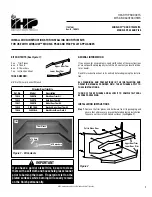
www.fmiproducts.com
116236-01M
21
7. Check to make sure that power cord is
completely clear of blower wheel and
that there are no foreign objects in blower
wheel. Also double check all wire leads
and make sure wire routing is not pinched
or in a precarious position. Correct ac
-
cordingly.
8. Turn on power to duplex outlet if previ
-
ously turned off per warning in column 1,
page 19.
9. Plug in blower power cord to duplex
outlet.
10. Blower will only run when speed control
knob is in the ON position and thermal
switch senses temperature after fireplace
begins to heat up. Blower speed can be
adjusted by rotating control knob. To turn
off, turn knob fully counterclockwise until
it clicks off. If blower is ON and has been
running with fireplace operating, blower
will continue to run for a short time after
fireplace has been turned off. As thermal
switch cools down, blower shuts down
automatically.
11. Peel off backing paper and stick supplied
wiring diagram decal on firebox bottom
approximately 12" in front of blower (see
Figure 28, page 20).
Blower Wiring Diagram
CAUTION: Label all wires
prior to disconnection when
servicing controls. Wiring errors
can cause improper and dan
-
gerous operation. Verify proper
operation after servicing.
FIREPLACE INSTALLATION
Continued
Figure 30 - Blower Wiring Diagram for
Thermostat-Controlled Models
Blue
Variable
Fan Switch
Fan Switch
(N.O.)
Green
White
On
110/115
V.A.C.
Blower
Motor
Black
Off
1
2
Black
INSTALLING GAS pIpING TO
FIREpLACE LOCATION
WARNING: A qualified
service person must connect
fireplace to gas supply. Follow
all local codes.
CAUTION: For propane/LP
units, never connect fireplace
directly to the propane/LP supply.
This heater requires an external
regulator (not supplied). Install
the external regulator between the
fireplace and propane/LP supply.
WARNING: For natural gas,
never connect heater to private
(non-utility) gas wells. This gas
is commonly known as wellhead
gas.
Installation Items Needed
Before installing fireplace, make sure you
have the items listed below.
• external regulator (supplied by installer)
• piping (check local codes)
• sealant (resistant to propane/LP gas)
• equipment shutoff valve *
• test gauge connection *
• sediment trap
• tee joint
• pipe wrench
• approved flexible gas line with gas connec
-
tor (if allowed by local codes)
* A equipment shutoff valve with 1/8" NPT
tap is an acceptable alternative to test gauge
connection.
For propane/LP connection only, the installer
must supply an external regulator. The exter
-
nal regulator will reduce incoming gas pres
-
sure. You must reduce incoming gas pressure
to between 11" and 14" of water. If you do
not reduce incoming gas pressure, fireplace
regulator damage could occur. Install exter
-
nal regulator with the vent pointing down as
shown in Figure 31, page 22. Pointing the vent
down protects it from freezing rain or sleet.
















































